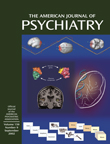Myocarditis With Quetiapine
To the Editor: To our knowledge, no case reports associating quetiapine treatment with myocarditis have yet been published, but two cases of cardiomyopathy with quetiapine administration are registered in the World Health Organization database (1). We present another case of myocarditis associated with quetiapine.
Mr. A, a 35-year-old man with paranoid schizophrenia, was admitted to a psychiatric hospital for the first time. Initially, he was medicated with benperidol and lorazepam, which led to the remission of acute psychosis. He developed extrapyramidal symptoms, and quetiapine, 800 mg/day, was introduced. On admission, a first-degree atrioventricular block and an incomplete right bundle-bunch block were diagnosed. No history of heart disease or cardiac risk factors was found.
During Mr. A’s first 2 months of monotherapy with quetiapine, 600 mg/day, mild eosinophilia (6% eosinophilia cells), thrombocytopenia (138 platelets/nl), and leukopenia (3.9 leukocytes/nl) developed. In the next 2 months, when Mr. A was still taking quetiapine without concomitant medications, a routine workup revealed high levels of creatinine kinase (107 U/liter), troponin (7.9 mg/liter), and C-reactive protein (75.9 mg/liter). In the last 4 days before the increase in his creatinine kinase level, Mr. A had a temperature of 37.8°C and reported nasal congestion with watery discharge, fatigue, and myalgia in the absence of chest pain.
Myocarditis was diagnosed on the basis of transient and ubiquitous ST wave elevation on ECG and elevation of cardiac enzyme levels. Nevertheless, myocardial infarction could not entirely be ruled out in the absence of catheterization. Mr. A’s ECG showed normal global pump function and no pericardial effusion; long-term ECG revealed no arrhythmia.
Since the origin of Mr. A’s myocarditis was unknown, quetiapine therapy was immediately withdrawn. He was treated with metoprolol, 10 mg/day, and ramipril, 2.5 mg/day. A decrease in Mr. A’s levels of troponin and creatinine kinase was observed in the next 4 days, and he was considered cardiologically stable. Within 2 weeks after discontinuation of quetiapine, his eosinophilia, thrombocytopenia, and leukopenia resolved. Amisulpride was initiated without recurrence of psychiatric or cardiac symptoms.
For this patient, myocarditis may have been the result of a hypersensitive reaction to quetiapine. Evidence for this is 1) the appearance of eosinophilia, leukopenia, and thrombocytopenia at the beginning of treatment and their resolution after drug termination and 2) the influenza-like symptoms at the time of diagnosis in the absence of any other evidence of infection or hypersensitivity reaction. Furthermore, quetiapine is chemically similar to clozapine and olanzapine, and it is known that with treatment with these atypical antipsychotics, cardiac hypersensitivity reactions can occur (2–4). Additionally, patients who die of myocarditis associated with clozapine have had eosinophilic infiltrates in the heart muscle (5). However, in contrast to our patient, who developed myocarditis 4 months after treatment, most cases occurred within 6 weeks of clozapine treatment (5, 6).
An alternative explanation is that the patient’s influenza-like symptoms reflected a viral etiology for myocarditis. However, this is unlikely, since cardiac symptoms usually begin 2 weeks after influenza symptoms appear. The fact that the patient’s ECG was pathological before introduction of quetiapine means that it was unlikely to have contributed to myocarditis. Right bundle-bunch block is a common finding in young patients; the patient’s atrioventricular heart block was neither aggravated with quetiapine treatment nor altered after its discontinuation.
Hypersensitivity reactions with quetiapine seem to be a parsimonious explanation for myocarditis in our patient. Clinicians should be alert to the potential appearance of this serious adverse effect when treating patients with quetiapine.
1. Coulter DM, Bate A, Meyboom RH, Lindquist M, Edwards IR: Antipsychotic drugs and heart muscle disorder in international pharmacovigilance: data mining study. Br Med J 2001; 322:1207-1209Crossref, Medline, Google Scholar
2. Jensen VE, Gotzsche O: [Allergic myocarditis in clozapine treatment]. Ugeskr Laeger 1994; 156:4151-4152 (Danish)Medline, Google Scholar
3. Meeker JE, Herrmann PW, Som CW, Reynolds PC: Clozapine tissue concentrations following an apparent suicidal overdose of Clozaril. J Anal Toxicol 1992; 16:54-56Crossref, Medline, Google Scholar
4. Raz A, Bergman R, Eilam O, Yungerman T, Hayek T: A case report of olanzapine-induced hypersensitivity syndrome. Am J Med Soc 2001; 321:156-158Crossref, Medline, Google Scholar
5. Killian JG, Kerr K, Lawrence C, Celermajer DS: Myocarditis and cardiomyopathy associated with clozapine. Lancet 1999; 354:1841-1845Crossref, Medline, Google Scholar
6. Hagg S, Spigset O, Bate A, Soderstrom TG: Myocarditis related to clozapine treatment. J Clin Psychopharmacol 2001; 21:382-388Crossref, Medline, Google Scholar



